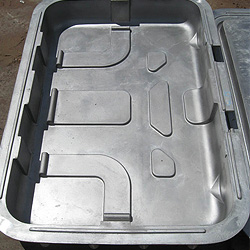
Non-Ferrous Metal Casting Technology and Its Basic Processes
March 17, 2016In working with the finest non-ferrous metals, the guesswork is taken out of the engineering process by adopting specialized casting techniques, methodologies that deliver competitively priced copper and aluminium components that exactly satisfy client specifications. Zinc and tin, lead and magnesium, these iron-free metals exhibit unique properties, designer-imbued characteristics that are set in stone by innovative product-shaping processes.
The Basics of the Non-Ferrous Metal Casting Work Model
Graded variants of nearly pure metal elements are heated and forced to assume a set shape in one casting station while carefully apportioned alloy flow white hot in a second cauldron. The thermal properties of these metallurgical elements are decidedly different from similarly toughened tiers of ferrous material, meaning the melting, casting, and heat treatment process diverges significantly. Among these differences, die casting is typically elected as the standard working process, though the technology has evolved somewhat by incorporating a vacuum-assisted mechanism. The metal is melted in a cauldron, with a special super-heated induction system generating a formidable thermal environment. Injected at high pressure into the die, the cavity is uniformly filled with metal until the ejecting phase is triggered, at which point the non-ferrous metal casting moves on to its finishing station.
Best for Highly Detailed Products
The intricate geometry of today's precisely engineered components demands the very best from these casting processes. A plain sand casting technique that employs reusable materials is perfect for large components, but finely wrought engine parts and geometrically advanced assemblies depend on a superior methodology. Car vendors, as one example, demand thinner wall surfaces and thermally efficient non-ferrous parts that exhibit this idealized geometry. Vacuum-assisted die casting reinforces the uniformity of the injected metal, minimising porosity and delivering the kind of final product that fits tight engineering parameters while retaining the inherent strength of the metal.
More Basic Processes
Investment casting shares some common features with silica, with the wax pattern used in the process melting during casting to enable fast reuse. Patterns move from sand and wax to wood and plastic, terminating in modern 3D printing solutions, a technology that's taking every manufacturing sector by storm. The advances found in the die casting stage next deliver a motion component into the mix to accompany high-quality injection formats, which leads us to rotational moulding dies and gravity moulding, processes that employ natural forces to distribute the non-ferrous liquid to the extremities of the mould.
In leveraging the latest in technological casting solutions, a foundry uses every tool, chemical, and law of physics to transform a thermal event into a set non-ferrous casting, a geometrically accurate representation of a client's desired dimensional requirements that exhibits unique metallic characteristics.
Optimized by NetwizardSEO.com.au
Recent posts
- Do's and Don’ts in Non-Ferrous Metal Casting
- Most Common Alloys Used In Die Casting
- Differences between Low Pressure and High Pressure Die Casting
- Differences between Shotblasting and Sandblasting
- How Different Types of Non-Ferrous Metals Respond To Different Moulding Temperatures
- Powder Coating Non-Ferrous Metals
- The Rotational Moulding Process
- Electric Induction Versus Gas Melting of Aluminium Alloys: What's the Difference?
- The Process of Metal Casting and Why Mould Matters?
- How Temperature Factors Affect Non-Ferrous Metal Castings
- Definition of Rapid Prototype Aluminum Casting Process
- Definition and Applications of a Blow Moulding Die
- Scope and Functions of a Rotomould in Non-Ferrous Metal Casting
- Properties of Non Ferrous Metals at Different Pouring Temperatures
- Different Types of Pattern Materials Used for Non-Ferrous Metal Castings
- What are Vacuum Moulding Dies?
- Most Common Uses and Applications of Non-Ferrous Metal Castings
- Non-Ferrous Metal Casting Technology and Its Basic Processes
- Aluminium Heat Treatment: An Overview
- Aluminium Casting Process: A Few Ideas on How This Is Done
- Definition of Moulding and Core Making Process
- Foundry Industry: Brief History and Definition